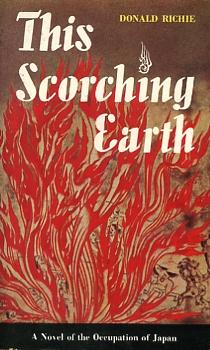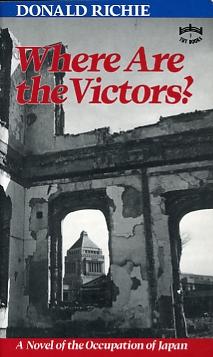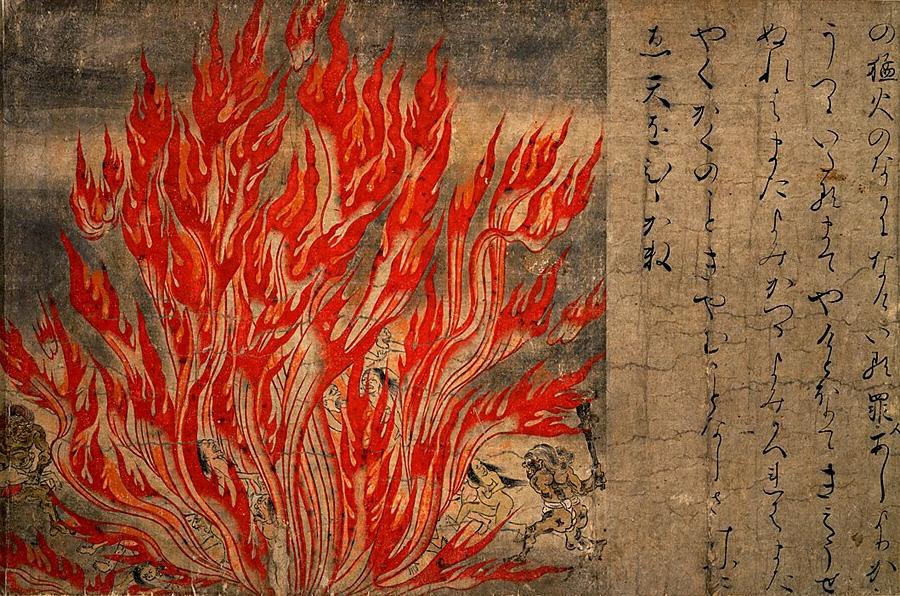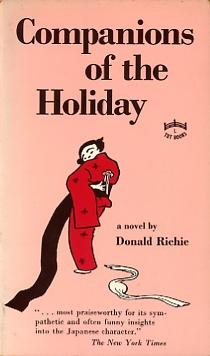
|
This Scorching Earth
As first titled (retitled) in print
1968 3rd printing (1st 1956)
|
|

|
Where Are the Victors?
As retitled with original title
1986 1st printing
|
|
From Jigoku zōshi, a 12th-century scroll of scenes from hell
Copped and compressed from Nara Kokuritsu Hakubutsukan
|

|
|
Occupational mood swings
Donald Richie
This Scorching Earth
(A Novel of Occupation Japan)
Tokyo: Charles E. Tuttle Co., 1956
317 pages, softcover
Dust jacket attached to spine
Illustrated by Takaba Ken'ichi
Donald Richie
This Scorching Earth
[A Novel of Occupation Japan]
Tokyo: Charles E. Tuttle Co., 1968
317 pages, paperback (preface 1967)
Cover design is detail from
Jigoku zoshi (Hell scroll)
12th century, Heian period
Tokyo Kokuritsu Hakubutsukan
[Tokyo National Museum]
Donald Richie
Where Are the Victors?
[A Novel of Occupation Japan]
Tokyo: Charles E. Tuttle Co., 1986
317 pages, paperback (Tut Books, preface 1985)
Donald Richie's first novel, published in 1956, was reissued in 1968 with a preface Richie wrote in 1967 for the reissue. The reissue was timed to the publication in 1968 of his second novel, Companions for the Holidays (see below).
The 1956 novel was reissued with a new (actually its original) title in 1986 with a preface Richie wrote in 1985, marking the 40th anniversary of the end of World War II and the start of Allied Occuaption of Japan.
The manner in which the two editions were promoted reflect the nature of the publishing beast. The difference in the two prefaces suggest what readers miss when an author's moods swing.
Top
Promotional blurbs
The following blurbs appeared on the inside of the front covers of the 1968 and 1986 paperback editions of Richie's 1956 novel as originally titled and as retitled. The hyperbole is typical of books put out not only by Tuttle but by other publishers that specialize in feeding the "cultural collision" of "Westerners" and "the Japanese". The underscoring marks phrasing that was different in the two editions.
|
Promotional blurbs
|
|
This Scorching Earth (1968)
". . . the best novel written about the occupation of Japan."
The Allied Occupation of Japan was more than an amazing military operation; it also was an created one of the most singular civilizations in modern history. It was made up of some of America's best minds and some of its worst, of some genuine idealists and some who simply 'never had it so good,' of some real altruists and some who rapidly got drunk on their new power. It was an astonishing and often terrifying little empire, a typical American small-town created in the middle of the largest city in Asia.
Now as dead as those of the Medes and the Persians, this remarkable if transient civilization deserves the brilliant historian it has found in the author of this explosively satiric novel. The story of a day and a night in the lives of some of the people who made the Occupation the mixed thing that it was, it silhouettes the Westerners against the background of Japanese, the occupied people -- and shows them all swept up in "the greatest cultural collision of modern times."
It is an historical novel, but it is not often that history gets such a shot in the arm as it does in this controversial, sometimes infuriating, often hilarious and always stimulating novel.
|
Where Are the Victors (1986)
The Allied Occupation of Japan was more than a military operation. It was an amazing collision of cultures, and it created one of the most singular civilizations in modern history. It was made up of some of America's best minds and some of its worst, of some genuine idealists and some who simply "never had it so good," of some real altruists and some who rapidly got drunk on their new power. It was an astonishing and disturbing little empire, a typical American small town created in the middle of the largest city in Asia.
This remarkable if transient civilization deserves the brilliant historian it has found in the author of this satiric and compassionate novel. The story of a day and a night in the lives of some of the people who made the Occupation the mixed thing that it was, it silhouettes the Westerners against the background of the Japanese, the occupied people -- and shows them all swept up in "the greatest cultural collision of modern times."
This moving, hilarious, critical, and deeply felt work well deserves its reputation as "the best novel written about the Occupation of Japan."
|
Top
Prefaces
The prefaces are so different in detail -- and so contrasting in how Richie characterizes the different versions of his novel -- as to deserve full dislosure.
|
Promotional blurbs
|
|
This Scorching Earth (1968)
Preface
This book is well over ten years old, having been written some time before it was first published in 1956. I started it almost twenty years ago when the Occupation was still on and I was a member of it. From these sketches and stories came the idea of this novel.
The original title was Where are the Victors?, from the final line of an old Japanese poem describing a forgotten battlefield. This had seemed to me appropriate to my subject, suggesting as it does the paradox (which I did not then know was a commonplace) that the winner of a war is also in some measure the loser.
What I wanted to show (I thought) was the coursening that victory brings any victors and, at the same time, the new virtues (undefined) that adversity presumably visits upon the vanquished. Actually, I was showing something else. I was furious at the Occupation for its treatment of the Japanese.
And what strikes me about this first novel, now that I read it again, is the amount of hate in it. I lash out, vicious, prejudiced, bristling with ill-will. Such hate as this is healthy enough but (as reviewers at the time pointed out) it limits the book as a novel. But then, though the title-page still calls it one, this book is not really a novel at all.
It is rather a connected series of portraits of people and places during those few years which saw the greatest head-on cultural collision of modern times. I happened to be there and I sketched what I saw. That I saw the Japanese as casualties, not of war but of the Occupation, one could call the bias of the historian as well as the inclination of the novelist. The lasting interest of the book, in so far as there is one, is that it is a personal document from the period. As a sanguine note in the first edition expressed it: "I hope my history is true enough for all who experienced the event to say: this is it -- this is how it was."
That little note is missing from this new edition because, in addition to its one truth, it contained a number of falsehoods -- ones such as "most of the events and all of the characters are creaters of my own imagination. The suspicious will search in vain to find themselves and people they knew. And rightly so because this 'novel' is innocent of even the most rudimentary character creation -- these are snap-shots of real people.
[ Omitted -- graph about where characters are and what they are doing at time of writing. ]
It is they who give the book whatever veracity it contains and it should be dedicated to them. That they do move around in a sometimes lifelike manner is indicated by their being occasionally recognized; that some of the situations are likewise lifelike I learned when people came up to tell me that they too had been at the Madame Butterfly catastrophe which concludes the book -- for that is the single section of the novel that I made up.
Donald Richie
Tokyo, 1967
|
Where Are the Victors (1986)
Preface
In this year of the fortieth anniversary of the end of World War II, and at the beginning of the Allied Occupation of Japan, I am pleased that my 1956 novel about this latter event is being reissued -- and is appearing for the first time under its original title.
Back then it was perhaps felt that Where Are the Victors? was too provocative a title, since it seemed to suggest that the losers were not entirely vanquished. Also there was the implication that the winner of a war is also in some measure the loser.
Now, forty years later, one often hears people wondering just who won the Pacific War anyway. What I had thought to be a paradox has become a commonplace. Japan's winning of major postwar economic battles has made many forget its wartime military defeats.
Perhaps this is the reason that interest in the Occupation period continues. People wonder what happened and why. This is also perhaps why my novel, originally wirtten as novelistic journalism, is now read as history.
It is reliable, as far as it goes. It is a connected series of portraits of people and places during those few years which saw the greatest head-on cultural collision of modern times. I happened to be there and I sketched what I saw. But I did not see everything. The bias of the journalist and the inclination of the novelist left lots out.
Strange -- this world was so alive when I was writing of it in 1948. And the Occupation was still going on when I was finishing this book in 1953. There are histories, to be sure, and artifacts in archives, but this book is perhaps all that remains to describe the texture of life during this Occupation, what it "felt" like.
And so I now wee, though I did not know it at the time, that I was really writing history, that I was in a way -- a biased, partial way -- preserving this strange, infuriating, admirable Allied Occupation of Japan.
Donald Richie
1985
|
Top
Poems inspiring titles
|
Poems inspiring titles
|
|
This Scorching Earth (1968)
What am I doing here
where my people unleashed
the age of horror,
sowing the plague
that will kill us all?
Can I be loved?
Is it possible
this earth will not scorch
the soles of my feet?
Lord Buddha nd Lord Christ,
help me to walk
lightly on this soil.
-- Lindley Williams Hubbell
|
Where Are the Victors (1986)
The cities in ruin
The land made waste,
Foxes and badgers now
Where armies once fought.
Where are the vanquished?
Where are the victors?
-- Early Chinese Poem
|
|
Lindley Williams Hubbell, born in the United States in 1901, died Hayashi Shūseki (林秋石) in 1994 in Japan, where he had come in 1953 and naturalized in 1960 -- four years after the publication of This Scorching Earth. A poet and translator, he came to Japan to catalogue the library of a Daitokuji in Kyoto, then became a professor of literature at Doshisha University.
I have not been able to identify the "Early Chinese Poem" which in the Preface Richie called an "old Japanese poem" (see above). The poem has the feel of a waka but could have been a kanshi. As a title, "Where are the victors?" appears to skew the spirit of the poem, though Richie's story also wonders what became of the vanquished.
|
Top

|
Companions of the Holiday
1977 1st Tuttle printing
|
|
Companions of the Holiday
Richie is also the author of the following novel, first published in 1968, set in Japan in the 1950s.
Donald Richie
Companions of the Holiday
New York and Tokyo: Walker/Weatherhill, 1968
197 pages, hardcover
Tokyo: Charles E. Tuttle Co., 1977
197 pages, paperback (Tut Books)
The title page shows the graph 友 and the novel is divided into five parts, three of them numbered and long, each headed with a single graph -- 多, 澄, 節, 春, 無. The copyright page attributes the calligraphy to Kayomi Takeuchi and glosses the six graphs respectively:
tomo (companions)
ta (many)
sumi (clarity)
setsu (integrity)
haru (spring)
mu (no one)
The graphs relate to the words that immediately follow them, namely:
友 COMPANIONS OF THE HOLIDAY
多 THE JAPANESE were waiting for the foreigner to leave.
澄 *I* SUMIKO WAS washing underwear . . .
節 *II* SETSU SAT over the monthly account . . .
春 *III* OHARU SAT upon the squeaking kitchen chair . . .
無 NO ONE was waiting for the mistress to return.
The novel begins much less cryptically like this (page 9, underscoring mine).
|
The Japanese were waiting for the foreigner to leave.
|
Who, from what viewpoint, would call the waiting people "the Japanese" and the object of their waiting "the foreigner"? It could only be someone who was in the habit, and needed to, talk about the people in the story this way.
There is, however, no foundation in the novel for such characterizing. Why, then, did Richie not write simply "They were waiting for her to leave" -- and allow the reader the evaluate the pronouns as the story unfolded? The only convincing explanation I can think of is that he himself was too much in the habit of writing about "Japanese" and "foreigners" -- as a journalist and film reviewer -- to suppress such labels when writing what he obviously intended to be a dramatization of a human condition that has nothing really to do with nationality.
The narrator immediately introduces old Setsu the cook and housekeeper -- young Sumiko the maid -- Hiroshi the chauffeur -- Oharu fat and uncomfortable in visiting finery -- the eggman knees bony and gray beneath khaki shorts -- and Saburo the meatboy muscles moving under the clean white shirt he has put on for the seeing-off. And again the narrator spoils such neutrality of voice by gratuitous labeling (page 10, underscoring mine).
|
Then a crow cawed once, an early lark fluttered in sudden flight, and down the garden path, her heels slipping on the flagstones still morning damp, her blonde cheeks bouncing with every step, teetering as she trotted holding in front of her whatevere she had forgotten, following the black dog, came the assistant manager's wife, mistress of the house, the foreigner for whom they had all been waiting.
|
Simply "the mistress of the house" would have been a sufficient evaluation of the "her" that the others were waiting for.
Promotional synposis
The following synopsis promoting Companions of the Holiday appears inside the front cover of the 1977 paperback edition.
|
. . . undoubtedly one of the finest novels by a foreign author ever to come out of Japan . . .
Ostensibly a story of the intrigues and squabbles among the servants in a Western household in contemporary Tokyo, this novel goes far beyond appearances to become a brilliantly understanted, hilariously restrained commentary upon Japanese charcter in general and upon human foibles everywhere.
Just a part of the book's wit is that the intricately structured plot itself is occasioned by a misunderstanding that occurs in the opening pages. From there it burgeons, rising to always greater complications, but always innocent of any bearing in fact at all, except in the facts of human nature.
Estrangement, argument, love obstructed and love fulfilled, death itself, cannot halt this tour de force, created in good will and with complete affection, until the final deflation, which summarizes both theme and charcters.
Not since The Honorable Picnic have the Japanese been examined with such affectionate irony and understanding. Perhaps never has a collision of cultures been presented with such wit, compassion, and wry humor.
|
By Roger Poidatz writing as Thomas Raucat, The Honorable Picnic is Richie's admitted favorite novel in English about Japan. First published in French in 1924, the English version, which came out in 1927 and again in 1937, was reincarnated after the war in Tuttle (1953, 1954), Viking (1955), and other editions.
Companions of the Holiday is clearly inspired by The Honorable Picnic. I am not sure that Richie himself didn't author Time Magazine's 1955 review of the Viking reissue of the novel, describing it as a farce about "a Westerner looking at the Japanese looking at themselves" -- which remains the voice of Companions of the Holiday despite Richie's attempt to suppress the "Westerner". See The Honorable Picnic for the reivew and other particulars.
|
Top
|



